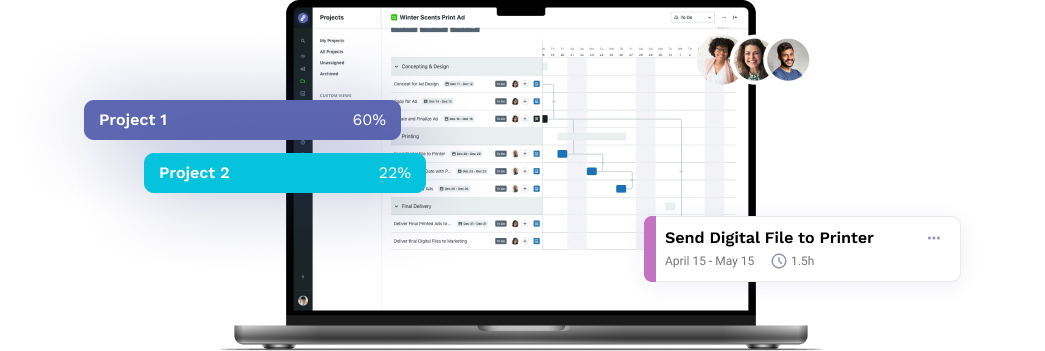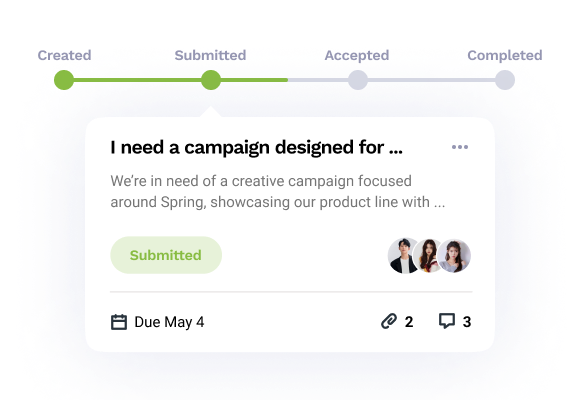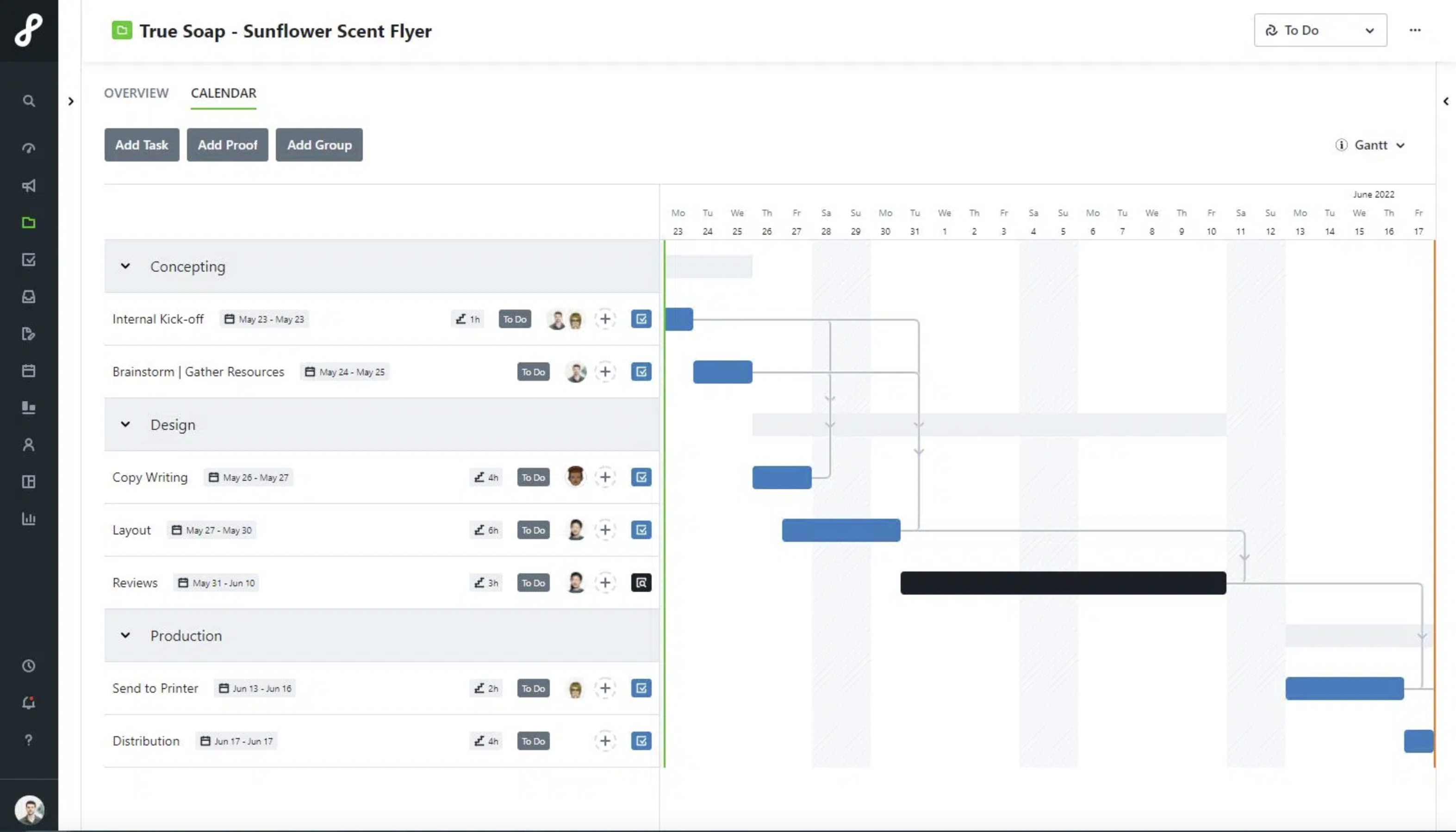
Ever feel like your creative projects are stuck in a never-ending loop of revisions and missed deadlines? You’re not alone. Managing a smooth creative workflow can seem like an impossible task, but it doesn’t have to be.
With the right process in place, you can turn chaos into order. In this article, we’ll show you how to implement a foolproof creative workflow process, using practical steps to make your life easier and your projects more successful.
Watch this video to understand how a creative operations platform can enhance your workflow.
Understanding the Creative Workflow Process
A creative workflow process is essential for ensuring that projects move smoothly from concept to completion. Based on Lytho’s four pillars of creative workflow, these stages help streamline the workflow, especially for remote teams.
1. Request Intake
The first step involves gathering all necessary information for a project. Custom, dynamic forms ensure stakeholders provide complete details up front, reducing back-and-forth communication and allowing the team to start work immediately.
2. Project Management
Having a single system of record is crucial. Project management tools track every campaign, project, proof, and task, ensuring that teams know the status of each project and nothing slips through the cracks.
Features like @mentioning, time tracking, and dynamic work views enhance collaboration and efficiency.
3. Review and Approval
A robust review and approval process is vital, especially for remote teams. Online proofing platforms with detailed markup tools, threaded comments, and automatic routing streamline feedback and approvals, ensuring timely and specific feedback.
4. Reporting
Custom reports help teams stay connected and informed about:
- What everyone is working on
- Top priorities
- New requests
- Blockers.
These reports facilitate transparency and coordination, crucial for maintaining a smooth workflow.
Identifying and Overcoming Challenges
In any creative workflow, challenges and bottlenecks are inevitable. Recognizing and addressing these issues promptly can make a significant difference in maintaining efficiency and quality. Here are some common challenges faced in creative workflows and strategies to overcome them:
Miscommunication
- Problem: Misunderstandings and lack of clear communication can lead to errors, duplicated work, and delays.
- Solution: Implement robust communication tools and protocols. Regular meetings, clear documentation, and platforms that support real-time collaboration and feedback can help keep everyone on the same page.
Inefficient Review and Approval Processes
- Problem: Multiple rounds of revisions and delays in feedback can slow down the project timeline.
- Solution: Streamline the review process by setting clear deadlines for feedback and using version control tools to track changes. Automated workflows can also ensure timely approvals and reduce the number of review rounds.
Resource Management
- Problem: Poor allocation and management of resources can result in overworked team members and underutilized assets.
- Solution: Use project management software to allocate resources effectively. Tracking resource usage and ensuring optimal distribution can improve efficiency and prevent burnout.
Scope Creep
- Problem: Uncontrolled changes or expansions in project scope can derail timelines and budgets.
- Solution: Define the project scope clearly from the beginning and use change management processes to handle any alterations. Regularly review project goals to stay aligned with the initial plan, and ensure all stakeholders understand and agree to scope changes before implementation.
Technology Limitations
- Problem: Outdated or inadequate technology can hinder the creative process.
- Solution: Invest in modern tools and platforms that support your workflow needs. Advanced features like creative asset management, automated task tracking, and integration capabilities can enhance efficiency and creativity.
Implementing a Streamlined Workflow
Creating an efficient creative workflow involves several key steps that ensure smooth progress from project initiation to final distribution. Here’s how to implement a streamlined workflow:
Project Kickoff
The first step is a thorough kickoff. Define the project’s objectives, goals, and desired outcomes to ensure all team members understand the project’s purpose. Develop a detailed project plan that includes:
- Timelines
- Milestones
- Deliverables.
To set the stage for a well-coordinated effort, assign specific roles and responsibilities to each team member based on their expertise.
Task Assignment
Breaking down the project into smaller, manageable tasks is essential. Assign these tasks to the appropriate team members and set realistic deadlines. Use project management tools to track these tasks and keep everything organized. This step is crucial for maintaining momentum and ensuring each part of the project progresses as planned.
Timeline Management
Develop a comprehensive timeline that covers all phases of the project, from ideation to final distribution. Regularly monitor the project’s progress against this timeline to identify any delays or issues early. Adjust the timeline as needed to accommodate changes without disrupting the overall workflow.
Review and Feedback
Regular review sessions are vital for evaluating the progress of the project. These sessions allow for:
- Gathering feedback from team members and stakeholders
- Identifying issues
- Making necessary adjustments.
Implementing feedback promptly ensures the project remains on track and meets the required standards.
Final Approval and Distribution
Before distribution, the project must receive final approval from key stakeholders. This step ensures the project meets all objectives and quality standards. Once approved, distribute the content through the appropriate channels. Monitoring the distribution process is crucial to ensure the content reaches its intended audience effectively.
Measuring and Optimizing the Workflow
To maintain an efficient creative workflow, it’s crucial to measure and optimize it regularly. This continuous improvement process helps identify areas needing enhancement and ensures high productivity and quality standards.
Regularly tracking performance provides insights into how well your workflow functions. Key performance indicators (KPIs) such as project completion times, the number of revisions, and resource utilization offer valuable data.
Key Metrics
- Time to Completion: Measure the duration from project start to finish to identify any delays.
- Number of Revisions: Track how many times a project is revised to spot communication or briefing issues.
- Resource Utilization: Evaluate how effectively your team and tools are being used.
- Client/Stakeholder Satisfaction: Collect feedback to understand satisfaction levels with the final deliverables.
- Budget Adherence: Monitor project costs to ensure they stay within budget.
Continuous Improvement
- Regular Reviews: Schedule frequent reviews to discuss what’s working and what isn’t. Gather team feedback to find improvement areas.
- Data Analysis: Use collected data to identify trends and patterns, informing decisions on necessary changes.
- Gradual Changes: Implement changes gradually to assess their impact and adjust as needed.
- Leverage Technology: Utilize advanced tools for automation and efficiency in tasks like file sharing and version control.
- Training and Development: Keep your team updated with the latest tools and best practices through regular training.
By following these steps, and regularly measuring and optimizing your workflow, you can ensure your creative projects are completed efficiently, on time, and to the highest quality standards.
Benefit From a Streamlined Creative Workflow Today With Lytho
Implementing a foolproof creative workflow process is essential for achieving efficiency, maintaining high-quality standards, and ensuring timely project completion. By addressing common challenges and leveraging modern tools and techniques, you can optimize your workflow and enhance your team’s productivity.
Ready to streamline your creative workflow process? Discover how Lytho’s creative workflow software and digital asset management solutions can optimize your processes and foster efficiency. Schedule a demo with Lytho today and see how our tools can transform your creative operations and help you achieve your project goals.
Do you want to give yourself and your creative team more room for creative stimulation by automating the boring stuff? Lytho helps you streamline your entire workflow and harmonize all brand collateral under a single, uniform platform. Feel free to reach out to us by scheduling a demo and learning how our creative solutions can boost the effectiveness of your creative projects. We look forward to speaking with you!

Ready to simplify your creative operations and start having a little fun at work again? Schedule time to talk with us.
Let us show you how Lytho’s Creative Operations Platform helps in-house creative and marketing teams do better work, ease the stakeholder experience, and stay on brand.
Schedule a Demo posted by
posted by 
